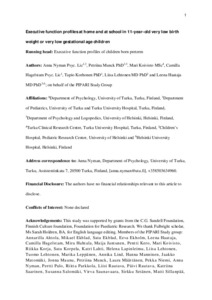Executive Function Profiles at Home and at School in 11-Year-Old Very Low Birth Weight or Very Low Gestational Age Children
Anna Nyman; Petriina Munck; Mari Koivisto; Camilla Hagelstam; Tapio Korhonen; Liisa Lehtonen; Leena Haataja
https://urn.fi/URN:NBN:fi-fe2021042821883
Tiivistelmä
OBJECTIVE:
Executive function (EF) problems of children born at very low birth weight (VLBW; ≤1500 g) or very low gestational age (VLGA; <32 gestational weeks) may present differently at school compared to the home environment. Ecological assessment of EF including parent- and teacher-rated profiles and associated risk factors of 11-year-old children born at VLBW or VLGA was evaluated.
METHODS:
A total of 125 VLBW or VLGA children and 132 controls were assessed using the Behavior Rating Inventory of EF, which includes 8 subscales that form the Behavioral Regulation and Metacognition Indexes. For VLBW or VLGA children, full-scale intelligence quotient (IQ) was assessed using the Wechsler Intelligence scale for Children, Fourth Edition. Neonatal data were collected systematically.
RESULTS:
VLBW or VLGA children with full-scale IQ ≥ 70 had clinically significant problems in the Working Memory subscale at school. Although they had clinically significant problems at home in the Behavioral Regulation Index, the difference disappeared when adjusted for paternal education. Lower gestational age, lower birth weight z-score, surgical necrotizing enterocolitis, low paternal and maternal education, and lower full-scale IQ were identified to be risk factors for higher scores in ecological assessment of EF.
CONCLUSION:
VLBW or VLGA children in this cohort exhibit fewer EF problems in ecological assessment of EF compared to previous literature. EF problems of this study population vary by home and school setting and are emphasized in working memory at school. Screening for EF problems in school environment is recommended to target the support.
Kokoelmat
- Rinnakkaistallenteet [27094]
